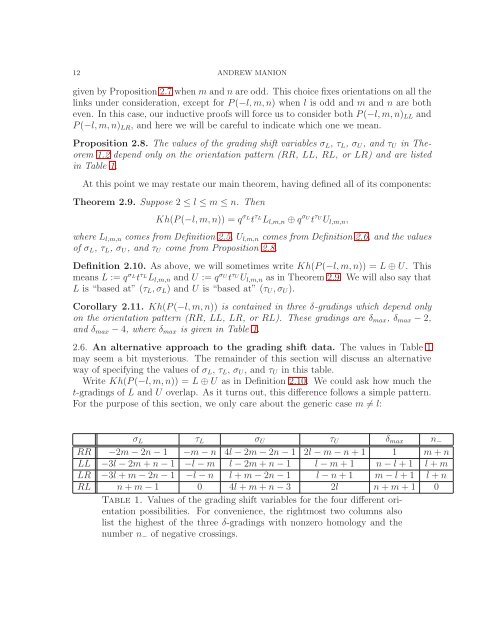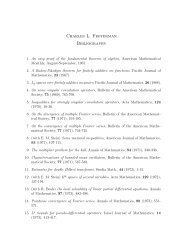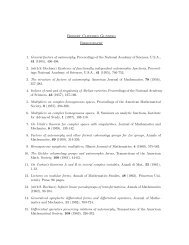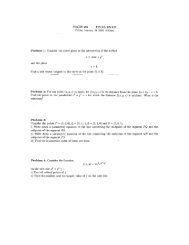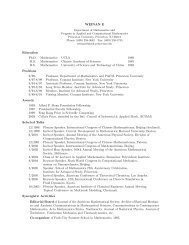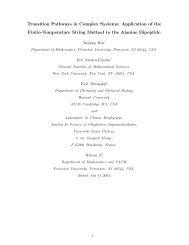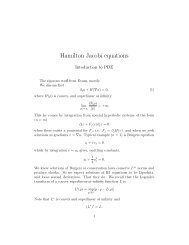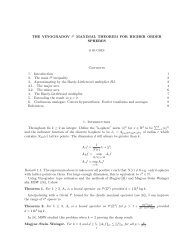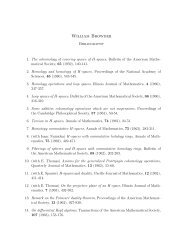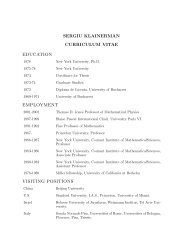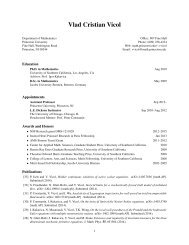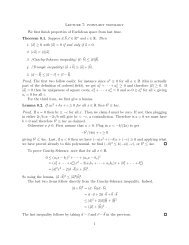The rational Khovanov homology of 3-strand pretzel links
The rational Khovanov homology of 3-strand pretzel links
The rational Khovanov homology of 3-strand pretzel links
Create successful ePaper yourself
Turn your PDF publications into a flip-book with our unique Google optimized e-Paper software.
12 ANDREW MANION<br />
given by Proposition 2.7 when m and n are odd. This choice fixes orientations on all the<br />
<strong>links</strong> under consideration, except for P(−l,m,n) when l is odd and m and n are both<br />
even. In this case, our inductive pro<strong>of</strong>s will force us to consider both P(−l,m,n) LL and<br />
P(−l,m,n) LR , and here we will be careful to indicate which one we mean.<br />
Proposition 2.8. <strong>The</strong> values <strong>of</strong> the grading shift variables σ L , τ L , σ U , and τ U in <strong>The</strong>orem<br />
1.2 depend only on the orientation pattern (RR, LL, RL, or LR) and are listed<br />
in Table 1.<br />
At this point we may restate our main theorem, having defined all <strong>of</strong> its components:<br />
<strong>The</strong>orem 2.9. Suppose 2 ≤ l ≤ m ≤ n. <strong>The</strong>n<br />
Kh(P(−l,m,n)) = q σ L<br />
t τ L<br />
L l,m,n ⊕ q σ U<br />
t τ U<br />
U l,m,n ,<br />
where L l,m,n comes from Definition 2.5, U l,m,n comes from Definition 2.6, and the values<br />
<strong>of</strong> σ L , τ L , σ U , and τ U come from Proposition 2.8.<br />
Definition 2.10. As above, we will sometimes write Kh(P(−l,m,n)) = L ⊕ U. This<br />
means L := q σ L<br />
t τ L<br />
L l,m,n and U := q σ U<br />
t τ U<br />
U l,m,n as in <strong>The</strong>orem 2.9. We will also say that<br />
L is “based at” (τ L ,σ L ) and U is “based at” (τ U ,σ U ).<br />
Corollary 2.11. Kh(P(−l,m,n)) is contained in three δ-gradings which depend only<br />
on the orientation pattern (RR, LL, LR, or RL). <strong>The</strong>se gradings are δ max , δ max − 2,<br />
and δ max − 4, where δ max is given in Table 1.<br />
2.6. An alternative approach to the grading shift data. <strong>The</strong> values in Table 1<br />
may seem a bit mysterious. <strong>The</strong> remainder <strong>of</strong> this section will discuss an alternative<br />
way <strong>of</strong> specifying the values <strong>of</strong> σ L , τ L , σ U , and τ U in this table.<br />
Write Kh(P(−l,m,n)) = L ⊕ U as in Definition 2.10. We could ask how much the<br />
t-gradings <strong>of</strong> L and U overlap. As it turns out, this difference follows a simple pattern.<br />
For the purpose <strong>of</strong> this section, we only care about the generic case m ≠ l:<br />
σ L τ L σ U τ U δ max n −<br />
RR −2m − 2n − 1 −m − n 4l − 2m − 2n − 1 2l − m − n + 1 1 m + n<br />
LL −3l − 2m + n − 1 −l − m l − 2m + n − 1 l − m + 1 n − l + 1 l + m<br />
LR −3l + m − 2n − 1 −l − n l + m − 2n − 1 l − n + 1 m − l + 1 l + n<br />
RL n + m − 1 0 4l + m + n − 3 2l n + m + 1 0<br />
Table 1. Values <strong>of</strong> the grading shift variables for the four different orientation<br />
possibilities. For convenience, the rightmost two columns also<br />
list the highest <strong>of</strong> the three δ-gradings with nonzero <strong>homology</strong> and the<br />
number n − <strong>of</strong> negative crossings.


